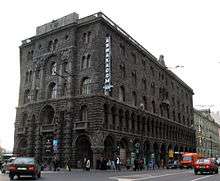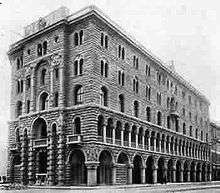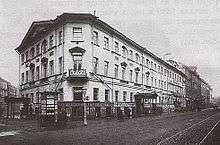Wawelberg Bank building



The Wawelberg Bank Building in St. Petersburg, Russia was built by the Wawelbergs - a prominent Polish banking family active in the Russian Empire. Although this building bears initials HW (Hipolit Wawelberg), it was commissioned by his son, Michael Wawelberg. It is located at 7/9 Nevsky Prospekt and is an important Nevsky Prospekt landmark. Architect Marian Peretiatkovich, also Peretyatkovich, Peretiatkowicz; Style: Historicism, Neo-Renaissance with elements of Art Nouveau
History
The present building was completed in 1912 and incorporates the foundation and some of the structure of two separate 18th century buildings. In the 18th century the property owners were two brothers, Semen (Semion) Bernikov and Sergei Bernikov, both wealthy merchants. In the early 19th century one T. Roby (Thomas Roby, Robbie, Т.Роби), a British subject, ran a restaurant or pub in this building. Supposedly this was the first public place in the city where ordinary Petersburgers got their taste of English steak, roast beef, pie and ale. Around the 1850s Bernikov's heirs sold one building to Shchepetilova, an army captain's widow, and the second structure to some Nochbeck, a government official. New owners in turn later sold the structure to another pair of merchant brothers, Nikolai (Nicholas) and Karl Korpus (Charles Corpus) who remained landlords until they sold both properties to Wawelberg interests in the early 20th century. From the 1870s until 1910 the building housed a variety of retail establishments and agencies: Captain Mahlein's (капитан Малейн) footwear shop, Betling s governess employment bureau (контора для найма гувернанток и Елизаветы Карловны Бетлинг). Art studios (of August Rakowski, a painter) occupied the mansard space, Ivanov's fruit emporium, Schaf's or Schaff's (Шаф) weapons and bicycle shop were also in the building before Wawelberg's takeover.
Architecture
The structure is a heavy Italianate palazzo built on gargantuan scale - it occupies a full city block. The exterior of the building is made of gray granite. Walls, cornices, columns are richly decorated with northern art nouveau inspired sculptures and bas-reliefs by two notable period sculptors Vasily Kozlov (Vassili, Василий Васильевич Козлов) and Leopold Dietrich (Леопольд Августович Дитрих). After 1917 Kozlov and Dietrich became official Soviet sculptors of the social realism persuasion. Many contemporaries considered the building too American, too tasteless, and its appearance generated some heated public debate. At the corner of Malaia Morskaia and Nevsky is an entrance to the actual bank, now housing a collection of travel agencies, from 1960 until 1992 the building was Leningrad headquarters of Aeroflot, the space is airy, quiet with entrance passage leading through a hall to the cavernous bank lobby, complete with rows of columns and a spacious gallery above. Wawelberg Bank is one of the most remarkable turn of the 20th century bank buildings in St. Petersburg. The exterior of the building bears HW - Hyppolite Wawelberg - initials set in an arrangement resembling a coat of arms.
References
| Wikimedia Commons has media related to Wawelberg Bank building. |
- Naom Sindalovskii - St. Petersburg, from Building to Building, 2002, Наум Синдаловский, Петербург от Дома к Дому. 2002
- Naom Sindalovskii - St. Petersburg Biographical Dictionary, 2002, Наум Синдаловский, Биографический словарь, 2002
- Nevsky Prospekt - the architectural guide (Boris Kirikov, Ludmila Kirikova, Olga Petrova) - Centropoligraph, Moscow, 2004 -(Невский проспект - Архитектурный путеводитель, Б. М. Кириков, Л.А. Кирикова, О.В. Петрова), Центрополиграф, Москва, 2004
Coordinates: 59°56′12″N 30°18′51″E / 59.93665°N 30.314198°E